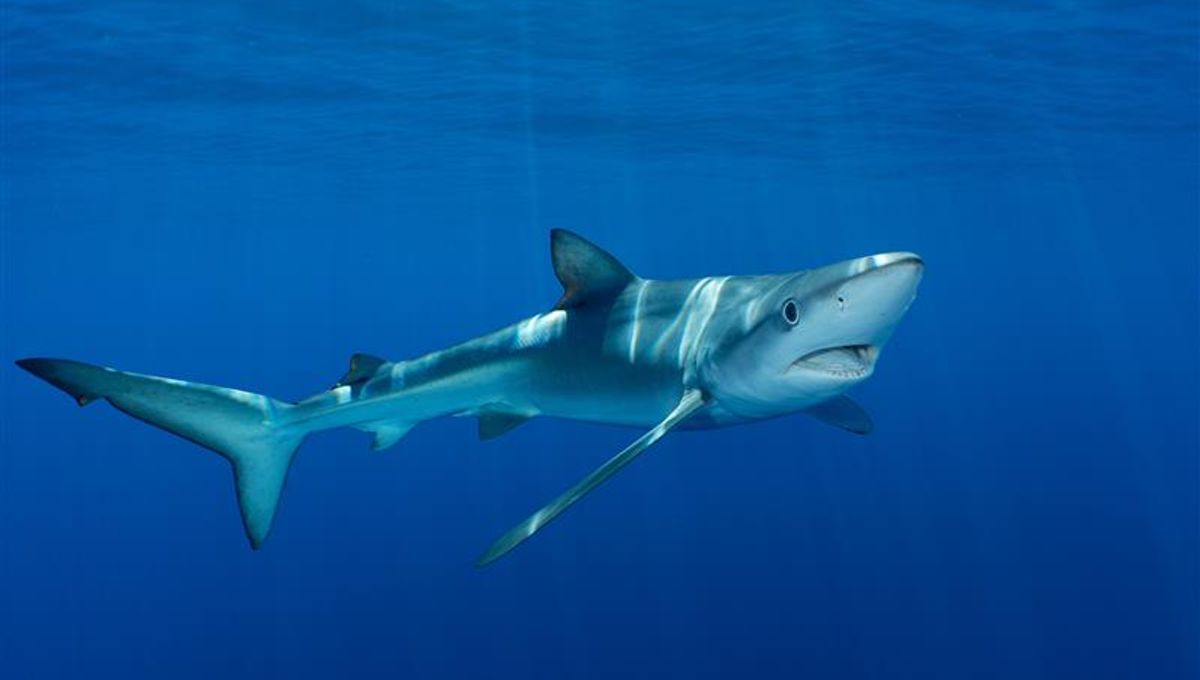
A fishing crew in southern Albania have caught a blue shark that, until then, had defied the odds. The animal had been skewered through its head by a swordfish and survived in what is the first known case of a shark living after receiving such a wound.
The shark was alive when it was pulled from the water by tuna fishers on February 17, 2023. The animal did not have any fresh puncture wounds at the time, and its stomach was filled with food. This suggests it had been eating normally. However, an autopsy found an 18.6-centimeter (7.3-inch) swordfish bill, known as a rostrum, lodged in its skull.
Blue sharks (Prionace glauca) and swordfish (Xiphias gladius) are both opportunistic apex predators who often share the same waters. This means they may compete for food and territory, or even hunt one another. Obviously this can lead to conflict, which can be deadly when one of the competitors is armed with a sharp pointed sword nose.
To date, there have been eight recorded incidents of blue sharks being impaled by swordfish, while similar incidents have been reported for other shark species, including bigeye thresher sharks (Alopias superciliosus) and shortfin mako (Isurus oxyrinchus).
A swordfish’s bill is used for feeding, defense, and hydrodynamics, so it’s an important implement for their survival. However, these activities can lead to them breaking off, which is a significant impediment for the fish, but not always a fatal one. Studies have shown instances where billfish with damaged or missing rostrums have lived with good physical health.
Less can be said about the sharks who tussled with these skewers. In all the previous cases, the impaled blue sharks did not survive their encounters with the swordfish rostrum. That’s what makes this latest specimen so interesting.
“When I realised that there was a swordfish bill inside the shark’s head, I was astonished,” Andrej Gajić at Sharklab ADRIA Research Centre in Vlorë, Albania, told New Scientist.
Gajić has conducted tens of thousands of shark autopsies over the years but had never encountered a situation like this. Typically, Gajić and colleagues attempt to revive and release sharks that are caught accidentally by commercial fishers, but the blue shark died before they could rescue it.
The animal measured 275 centimeters (9 feet) and weighed 44 kilograms (97 pounds), which is quite small when compared to swordfish that have been known to grow up to 455 centimeters (14.9 feet) and weigh up to 650 kilograms (1,433 pounds).
Given these potential disparities between the two fish, you might wonder why they would come to blows in the first place, but there are several reasons why this can happen.
“The interactions between blue sharks and swordfish are complex and multifaceted, particularly those resulting in conflicts and impalements,” Gajić writes in a new paper. “In both the current and previously documented studies, swordfish rostrums have been found in or near the head region of sharks, suggesting a precise targeting of vital and vulnerable points.”
Blue sharks are known to eat swordfish in some parts of the world, so it may have been an attack gone wrong. Alternatively, the two animals may have been competing for the same prey and the two collided.
“Both blue sharks and swordfish feed on similar prey, such as high-density schools of fish or squid. In such environments, the aggressive hunting tactics of both species could lead to accidental collisions and subsequent impalements,” Gajić added.
Although we may never know the circumstances that led this blue shark to get its head impaled, it does call for more detailed observations of the interactions between swordfish and sharks. This may help us understand whether such wounds are sustained from aggressive behavior or misadventure.
The study is published in the journal Marine Biodiversity.
Source Link: Incredibly, A Blue Shark Survived Being Impaled Through The Skull By A Swordfish